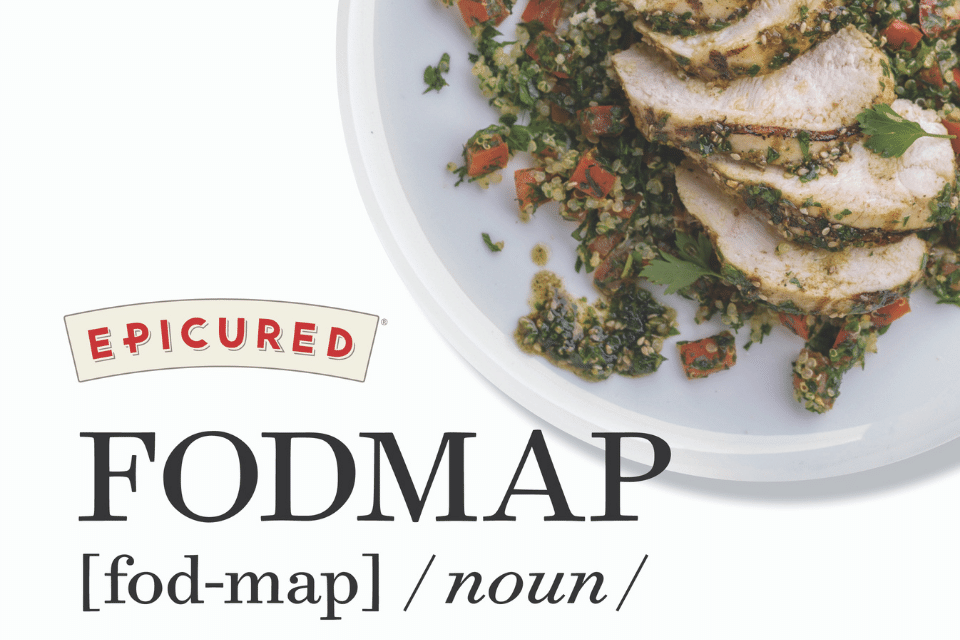Has your gastroenterologist or dietitian recommended that you try a Low FODMAP diet for your Irritable Bowel Syndrome (IBS)? It can feel like a daunting experience (no garlic?!) but it certainly doesn’t have to be! Read on for 10 things that you should know before starting on your Low FODMAP journey.
1. What does FODMAP stand for?
FODMAP stands for Fermentable Oligosaccharides, Disaccharides, Monosaccharides, And Polyols. They’re carbohydrates, more specifically fibers and sugars, that are not completely digested or absorbed in our intestines. Oligosaccharides are broken down into Fructans and Galactooligosaccharides (GOS). We all malabsorb these sugars as we do not have the enzymes to break them down. They are fermented by our gut bacteria causing gas.
While this is not a bad thing (it’s a normal part of digestion!), when you have IBS it may cause uncomfortable symptoms like bloating, abdominal pain, and altered gut motility. Disaccharides consist of Lactose, which is a milk sugar. We need the lactase enzyme (located in our small intestine) in order to break down lactose. If we do not have enough lactose, water is pulled into our colon causing symptoms. Monosaccharides consist of Fructose, which may be malabsorbed by some people as it is the smallest FODMAP and attracts water into the colon. Finally, polyols are broken up into Sorbitol and Mannitol. These can be found naturally in certain foods or may be artificial sweeteners. Like fructose, they are also small in size. This makes it easy for them to attract water into the colon, causing symptoms like bloating and diarrhea.
2. Where can we find them?
FODMAPs can be found in a wide variety of foods like fruits, vegetables, whole grains, legumes, and nuts. Common foods include wheat, garlic, onion, beans, apples, peaches, asparagus, cauliflower, cow’s milk, ice cream, honey, cashews, and pistachios, as well as many more.
3. They’re portion size dependent.
Through testing by Monash University, they have found that FODMAPs are portion size dependent. This means that you can tolerate eating a small amount of wheat pasta while in the elimination phase, or if that specific FODMAP is your trigger, but if you have a larger portion size then you may experience digestive symptoms.
4. Who should follow a low FODMAP diet?
A low FODMAP diet was initially studied in those with IBS. Recent studies have shown that it may provide symptom management in those suffering from Inflammatory Bowel Disease (IBS), which includes Crohn’s and Ulcerative Colitis. Clinical trials are taking place for the Low FODMAP diet and Small Intestinal Bacterial Overgrowth (SIBO). This diet is not meant for those who already have severe food restrictions, allergies, or those with active eating disorders.
5. Who can help me with this diet?
Your gastroenterologist will be the one to diagnose you with IBS and may recommend a trial of the Low FODMAP diet. They may also refer you to a Registered Dietitian to help you through the phases of the diet. Be sure to look for a dietitian who has received training by either Monash University or another dietitian.
6. How long should I follow this for?
The Low FODMAP diet is a short term diet that has three phases. The elimination, reintroduction and personalization phases take a few months to get through. The elimination phase lasts 2-6 weeks, with many people finding symptom relief within the first couple weeks. Once you’ve completed the elimination, you then start the Reintroduction (aka Challenge Phase), which lasts 8-12 weeks depending on a variety of factors. The third phase is the Personalization Phase, which is your long term diet. You’ve identified what your FODMAP triggers are and now you’re ready to add back in all the other FODMAPs that you’ve been restricting. You may find that you only need to limit one or two FODMAPs, depending on the severity of your symptoms.
7. Are they good? Bad?
FODMAPs are extremely important for our microbiome, as many of them act as prebiotics (aka food for our gut bacteria). However, when you have IBS, certain FODMAPs may trigger digestive symptoms. It’s important to note that not all FODMAPs will cause symptoms. This is another reason why it’s extremely important to go through all three phases of the diet and not unnecessarily over restrict.
8. It’s not a dairy-free or gluten-free diet.
The Low FODMAP diet is actually a low lactose diet as you can have lactose-free milk, yogurt and ice cream as well as low lactose cheese (like Cheddar, Parmesan and Swiss). It’s not a gluten-free diet either. Many naturally gluten-free grains happen to be low FODMAP (like quinoa and brown rice) but you can have small amounts of wheat through pasta and Sourdough bread.
Calling it a dairy-free or gluten-free diet can be misleading because you may start including products that are actually high FODMAP. Things to look out for are large portion sizes of coconut or oat milk and milks made from soybeans (as opposed to soy protein). Soy and coconut flour are common ingredients in gluten-free flour blends.
9. You can still include a wide variety of foods — they’re just portion size dependent.
It’s recommended to use the Monash University FODMAP app for accurate portion sizes so that you can still include a variety of these foods in your diet.
10. You can absolutely meet your fiber needs.
A common misconception is that the Low FODMAP diet is a Low Fiber diet because you’re eliminating so many carbohydrates. Luckily, since it is portion size dependent, you are able to include small amounts of high fiber products like flaxseeds, beans, lentils, sweet potatoes and broccoli.


